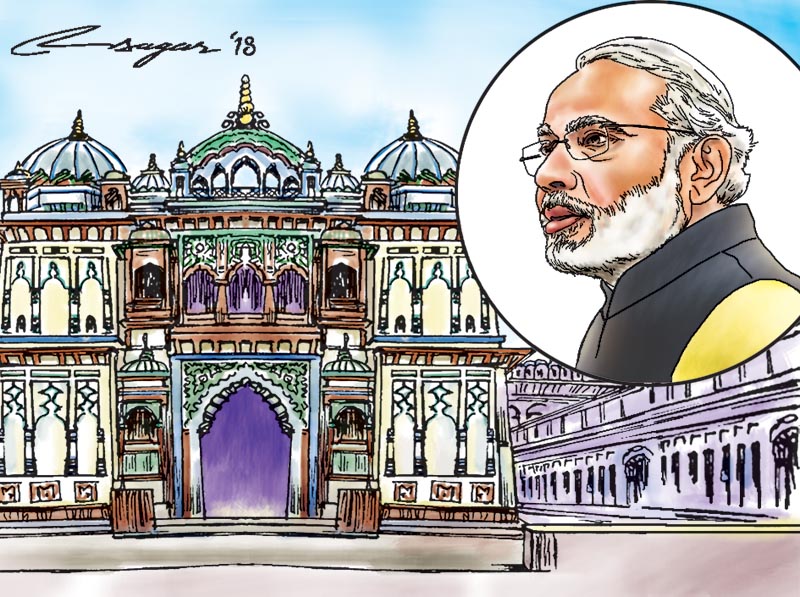Modi in Janakpur: Cementing bilateral ties
Indian PM Modi’s visit to Janakpur, the capital city of Mithila, which was the educational, cultural and spiritual hub of the entire civilisation of the Indian sub-continent, will certainly help uplift the traditional, spiritual, cultural and social ties that exist between Nepal and India
“Janakpur First” obviously appears to be the main message Indian Prime Minister Narendra Modi wants to send to Nepal during his two-day visit scheduled for May 11-12.
Never in the past has any high-level government dignitary from India -- or from any other country of the world -- ever thought of touching the holy land of Janakpur before visiting Kathmandu, the Capital.
This unusual gesture and high regards from Modi for Janakpur seems to have been in his mind even in August 2014, as during his speech in then Parliament he had expressed his desire to visit Janakpur, the birthplace of Kishoriji, widely known as Sita or Janaki who married Lord Ram of Ayodhya some 10,000 years ago during the Ramayan period.
Unfortunately, the situation unfolded in such a way that Modi could not visit Janakpur when he landed in Kathmandu in November the same year to attend the 18th SAARC Summit.
Since his desire to visit this land of Janakpur that lies in the southern part of Nepal in the Mahesh/Tarai region about 14 kilometres from Nepal-India border could not be fulfilled then, during this upcoming visit to Nepal, third since he became the prime minister of India, he willingly chose to land in Janakpur first, even before visiting Muktinath, yet another religious site for Hindus and Buddhist, and Kathmandu.
In the ancient time, Janakpur, the capital city of Mithila, was the educational, cultural and spiritual hub of the entire civilisation of the Indian sub-continent.
Following the Sugauli Treaty in 1816 between the Nepali rulers and the British East India Company, the northern part of ancient Mithila state, including Janakpur, became part of Nepal, while the southern part went into India.
However, on account of the open border system between Nepal and India, social, cultural, religious and economic ties among the people of the two countries have remained intact. As a result, each year hundreds of thousands of Nepali and Indian people, particularly those living in the border regions, enter into a marriage relationship, which has been making a positive impact on Nepal-India relations.
However, Modi’s love for Janakpur is more due to his spiritual connection with this land. As it is well known, Siradhwaj Janak, the King of Mithila, was not merely a statesman of his time; he was also a Karm Yogi, the one who remains connected with the Almighty God even while performing worldly duties. Modi, in fact, seems to be heavily influenced in his day-to-day life by King Janak of Mithila.
Like King Janak, who is widely renowned as Videha, lived beyond the body by remaining detached from worldly pleasures, Modi too seems to be least attached with the world, just while he undertakes the duty of the prime minister of India, the world’s largest democracy, which is the second most populous country in the world with the highest economic growth rate.
There is hardly any person in his family, social and political life with whom he is attached, yet he is more humanistic than any other person who claims himself to be so.
Moreover, King Janak was the disciple of one of the most spiritually enlightened masters of the world, Ashtavakra. In the same way, Modi is also influenced by the enlightened Guru who happened to change the course of his life from his desire to remain as a Yogi deeply rooted in meditation, abandoning all the worldly duties, who dwells in meditation without giving up any worldly duties.
Perhaps, few people know Modi holds the Bhagwat Geeta, the spiritual text in which Lord Krishna tries to enlighten his disciple Arjuna in the battlefield of Kurukshetra near Delhi in India some 5,000 years ago through the discourse, dear. In this discourse, Lord Krishna tries to make Arjuna spiritually sound while fighting with enemies for the cause of Dharma, the truth.
Coincidently, King Janak also gets enlightenment from his Guru Ashtavakra during the discourse itself, which later on was named as Ashtavakra Geeta, the most influential spiritual text of the world. The sum and substance of this Geeta that came into existence almost 5,000 years before the Bhagwat Geeta is to develop a feeling of liberation, the guiding force to become enlightened. Possibly, Modi might have been influenced by Ashtavakra Geeta as well, apart from Bhagwat Geeta, which has a profound impact on his life.
Thus, the “Janakpur First” mission of Indian Prime Minister Modi is not without a reason. The visit is more inclined to uplifting the traditional, spiritual, cultural and social relations that exist between Nepal and India.
This is the reason why he will come to Janakpur straight from Patna (India) by a helicopter where he will first worship Kishoriji at the Janaki temple in the morning before addressing a public gathering at Barahbigha Maidan where people from different parts of Nepal and India, and especially from the newly formed Province 2, will greet him.
Nepal should take it as a pride that the Indian prime minister is so much influenced by the enlightened Nepali philosopher King Janak, and Sita who is the daughter of this country.
Jha is an economic and political analyst






